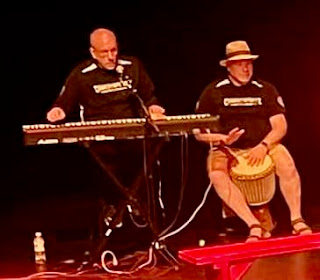Two Miles High, Part III: Orange Sky at Dawn
The day dawned orange.
That may not seem extraordinary to you. Around the world,
sunrises and sunsets are often tinged with red and orange. The difference here,
almost 10,000 feet above sea level, is that the orange lingered.
We were up by 6:30, having discovered that our brilliant
plan of saving space and weight by forgoing pillows in favor of rolled-up rain
coats had left much to be desired. The following night, we would find that our
brilliant substitute plan, using Ziploc bags filled with underwear and wrapped
in our down vests, would yield similar results: anything not actually a pillow
will eventually feel more like a rock. Retrieving the bear can, having
breakfast, breaking camp, and repacking bumped our departure time from this
location to 8:30. The sun was well up in the sky by now, and everything was
still orange.
We knew what was causing this: the huge fire in the
Sawtooths that had led us to change our hiking destination. What we hadn’t
bargained for is that the smoke would travel this far, hundreds of miles to the
east, casting a sickly haze over the sky that had been such a brilliant blue
the day before, turning everything orange. I remembered this effect from the
years I spent in the Willamette Valley back in the days when the practice of field
burning—grass seed farmers’ preferred method of removing stubble and
sterilizing their post-harvest soil—cast a smoky pall over the too hazy, lazy
days of summer’s end. It also gave me bronchitis.
The view from the pass was nothing special, a characteristic I have found in many mountain passes over the years; even so, I had hoped for at least a glimpse of Death Canyon, one of the great backpacking routes. Meek Pass also marks the border between the Jedediah Smith Wilderness and the Grand Teton National Park, so we could at least say we dipped our toes into it.
 The trail now took us down the Sheep Steps. On the way we
glimpsed our first marmot, a sort of cross between an otter and a seal that,
despite its resemblance to aquatic mammals, lives in the arid Rocky Mountains
(we had previously seen one at the Cedar Breaks, in Utah). The Sheep Steps were
no problem. We came to the junction of the Teton Canyon Trail, the Teton Ridge
Trail, and the Alaska Basin Trail, and another point of decision: 1.8 miles
further on the ridge trail would take us to Hurrican Pass, a place that, unlike
Meek and so many other passes, promised views of actual mountains: the
eponymous Grand Tetons. On the way , we could make a campsite at Sunset Lake.
But now we came up against a complication: the poor night’s sleep, the
altitude, and the backpacking had taken a toll on Amy, and she badly needed to
rest. I wrestled with my desire to press on, to reach a high altitude goal and
a viewpoint, and fought it down. “All right,” I said, “Let’s make camp here.”
The trail now took us down the Sheep Steps. On the way we
glimpsed our first marmot, a sort of cross between an otter and a seal that,
despite its resemblance to aquatic mammals, lives in the arid Rocky Mountains
(we had previously seen one at the Cedar Breaks, in Utah). The Sheep Steps were
no problem. We came to the junction of the Teton Canyon Trail, the Teton Ridge
Trail, and the Alaska Basin Trail, and another point of decision: 1.8 miles
further on the ridge trail would take us to Hurrican Pass, a place that, unlike
Meek and so many other passes, promised views of actual mountains: the
eponymous Grand Tetons. On the way , we could make a campsite at Sunset Lake.
But now we came up against a complication: the poor night’s sleep, the
altitude, and the backpacking had taken a toll on Amy, and she badly needed to
rest. I wrestled with my desire to press on, to reach a high altitude goal and
a viewpoint, and fought it down. “All right,” I said, “Let’s make camp here.”
We climbed a small hill, and found ourselves on the shore of
the first small lake in the basin, with ample campsites and a grove of trees
crying out to host a bear can: in fact, I could already see two hanging from
them. We pitched the tent, inflated the mattresses, rolled out the sleeping
bags, and Amy lay down for a nap.
As she slept, I continued wrestling with my completist
impulses. I busied myself with scouting the bear can area, then walked to the
lake’s edge, and gasped at what I was seeing: a perfectly reflecting mirror
lake, with Buck Mountain looming over it. Buck Mountain is everything a Rocky
Mountain should be: a pinnacle of stone thrusting out of the earth, independent
enough of its neighbors to have its own distinct identity. In short, it was a
Teton. We didn’t have to climb to the pass to see this one. In fact, I
discovered as I consulted the map, the Alaska Basin Loop would take us right to
the foot of Buck Mountain, as well as its immediate neighbor, Veiled Peak.







Comments
Post a Comment